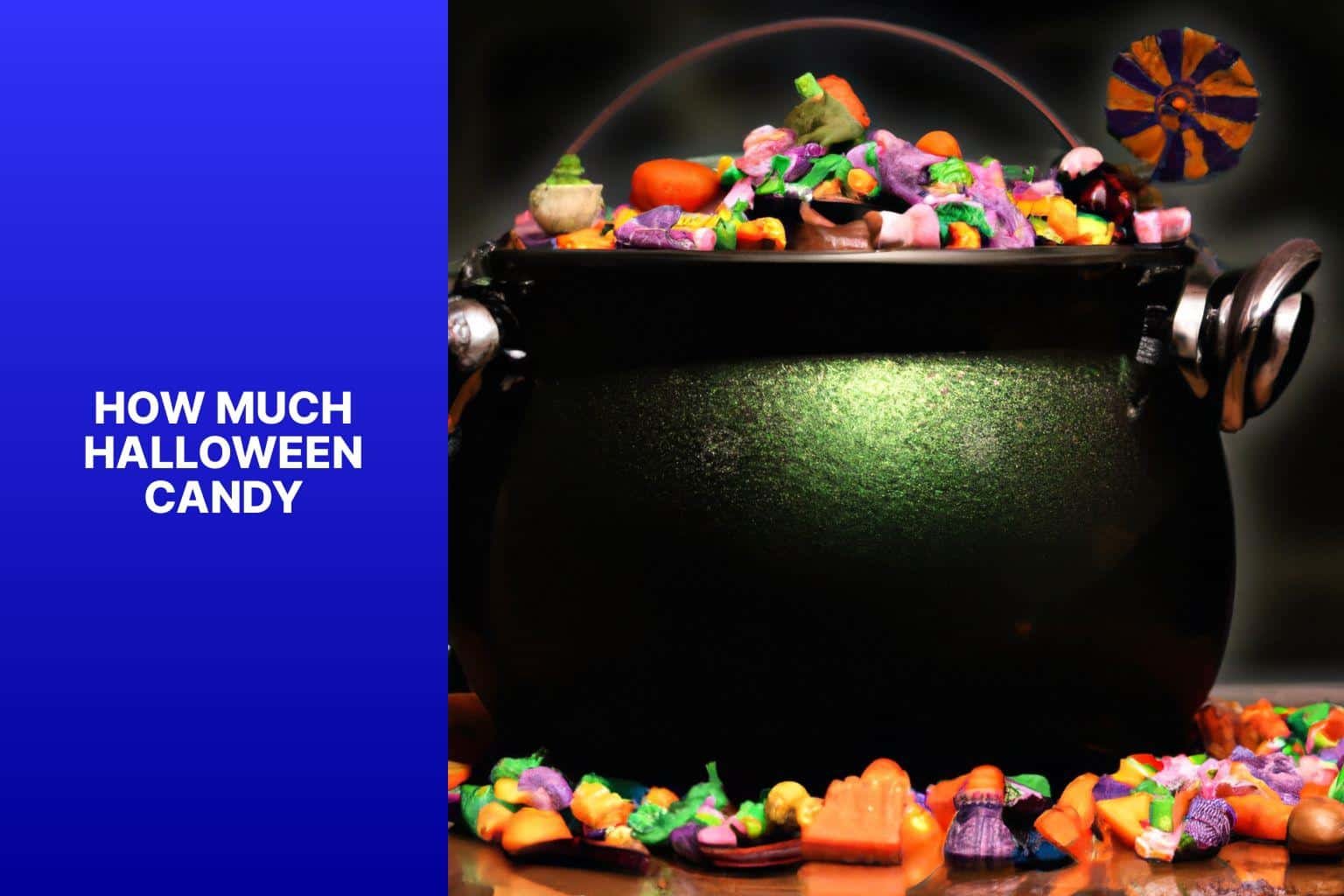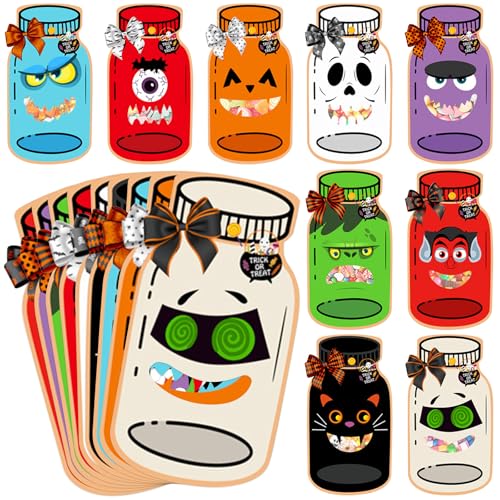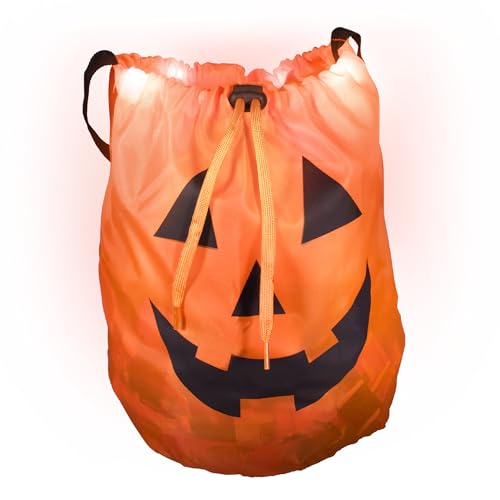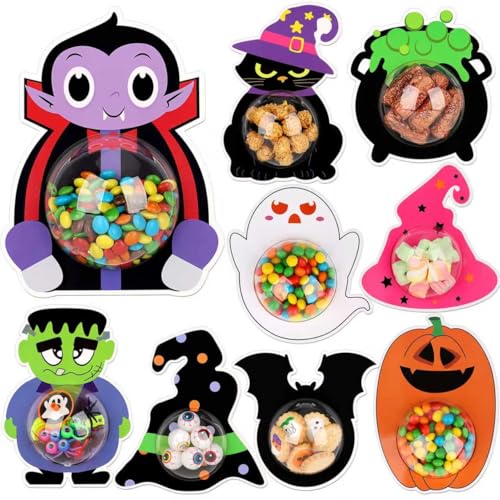How Much Halloween Candy Should You Eat? That’s the question many people face during the Halloween season, as the abundance of sweets can be tempting. While indulging in some Halloween treats is part of the fun, it’s important to strike a balance and consider factors that determine the amount of candy you should consume.
Factors such as age, health considerations, and personal dietary restrictions play a role in determining Halloween candy consumption. Young children may have different limits compared to adults, and individuals with certain health conditions should exercise caution when consuming sugary treats. Considering the recommended daily sugar intake is crucial for maintaining a balanced diet.
Consuming too much Halloween candy can have its risks. It’s important to be aware of these risks, which include an increased risk of tooth decay, weight gain, and obesity, as well as blood sugar spikes. With moderation and mindful eating, these risks can be mitigated.
To moderate Halloween candy consumption, there are several tips you can follow. Setting limits on the amount of candy you or your children can consume, practicing portion control, and offsetting candy intake with healthy choices are all effective strategies.
Once Halloween is over, handling leftover candy becomes a consideration. Donating excess candy to local charities or food banks is a great way to give back to the community. Alternatively, freezing candy for later use or repurposing it in baking or desserts are creative ways to make the most of the leftover treats.
By considering these factors and following moderation guidelines, you can enjoy Halloween candy in a responsible and balanced way.
Key takeaway:
- Determining a suitable amount: Consider age, health factors, personal dietary restrictions, and recommended daily sugar intake when deciding how much Halloween candy to consume.
- Risks of excessive consumption: Excessive Halloween candy consumption can lead to increased risk of tooth decay, weight gain, obesity, and blood sugar spikes.
- Managing candy consumption: Set limits, practice portion control, and balance candy intake with healthier choices to moderate Halloween candy consumption.
- Handling leftover candy: Donate to a charity or food bank, freeze for later use, or repurpose in baking or desserts to manage leftover Halloween candy.
How Much Halloween Candy Should You Eat?
When it comes to Halloween candy, you may be wondering how much Halloween candy you should eat. Well, fret not! I am here to guide you through it.
To maintain a balanced diet, it is important to consider portion sizes when indulging in Halloween treats. Allow me to provide you with some helpful guidelines:
1. Mind serving sizes: Take a moment to check the nutritional information on the candy packaging. This will help you determine the appropriate serving size, whether it is measured in pieces or ounces.
2. Limit sugary treats: It is crucial to avoid excessive candy consumption. This can potentially lead to cavities and unwanted weight gain. Instead, enjoy a moderate amount of candy.
3. Consider calorie intake: Candy tends to be high in calories and lacks nutritional value. Hence, it is essential to be mindful of the calories you consume. Adjust your overall diet accordingly to compensate for the candy intake.
4. Listen to your body: Pay close attention to your feelings of fullness and satisfaction. Once you have had enough candy, it is wise to stop eating. Don’t worry, you can always save the rest for later.
5. Find alternatives: If you are concerned about overindulging, why not offer non-candy treats to trick-or-treaters? You can also enjoy healthier Halloween-themed snacks like pumpkin seeds or fruit.
Let me share a story about my friend Sarah. Last Halloween, she successfully limited her candy intake to only three small pieces throughout the night. By sticking to this goal, she was able to enjoy the holiday and satisfy her sweet tooth without any guilt or negative health effects. Remember, it is all about finding a balance that works for you and your body.
So, how much Halloween candy should you eat? Follow these guidelines and listen to your body’s signals. Happy Halloween!
Determining Halloween Candy Consumption
Curious about how much Halloween candy you can enjoy guilt-free? Join us as we uncover the key factors that determine Halloween candy consumption. From age and health considerations to personal dietary restrictions, we’ll delve into the fascinating world of Halloween treats. Plus, we’ll shed light on the recommended daily sugar intake to help you make informed decisions during this festive season. Get ready for a delicious exploration!
Age and Health Factors
To take into account age and health factors, consider the appropriate consumption of Halloween candy. These factors play a crucial role in understanding the amount of candy an individual can consume without adverse effects on their health.
| Age Group | Health Factors |
| Children (3-12 years) | Children, with developing teeth and smaller bodies, are more susceptible to risks from excessive sugar intake. Children should limit candy consumption to 10-15% of their daily caloric intake. |
| Teenagers (13-17 years) | Teenagers, with higher caloric needs due to growth and physical activity, should consume candy in moderation and balance it with a nutritious diet. Excessive consumption can lead to weight gain and dental issues. |
| Adults | Adults can handle slightly higher candy intake due to their fully developed bodies. They should still be mindful of overall sugar intake and maintain a balanced diet to prevent health problems and weight gain. |
Fact: According to the American Heart Association, men should not consume more than 36 grams (9 teaspoons) of added sugar per day, and women should not consume more than 25 grams (6 teaspoons) per day, including sugars from all sources, such as Halloween candy.
Personal Dietary Restrictions
When deciding which Halloween candies to eat, it’s important to take into account personal dietary restrictions. Here are a few things to consider:
- If you have any allergies, make sure to carefully read ingredient labels to avoid candies that contain nuts, dairy, or gluten.
- For those with specific dietary preferences, opt for candies that adhere to vegan or vegetarian diets. Look for candies that are labeled as vegan or vegetarian.
- If you are watching your sugar intake, choose candies that are low in sugar or sugar-free. Be sure to check the packaging for nutritional information.
- If you have any health conditions such as diabetes or high blood pressure, it’s advisable to consult with a healthcare professional to determine the best candy choices for you.
By taking personal dietary restrictions into consideration, individuals can make informed choices that cater to their health needs and preferences while still enjoying the Halloween festivities.
Recommended Daily Sugar Intake
The recommended daily sugar intake varies based on age and health factors. Here are the guidelines:
| Age Group | Recommended Daily Sugar Intake |
|---|---|
| Children (1-3 years old) | No more than 25 grams (6 teaspoons) |
| Children (4-8 years old) | No more than 30 grams (7 teaspoons) |
| Children and Adolescents (9-18 years old) | No more than 50 grams (12 teaspoons) |
| Adults | No more than 50 grams (12 teaspoons) |
These recommendations apply to added sugars in foods and beverages. Naturally occurring sugars in fruits and dairy products are not included. Consuming excessive sugar can lead to various health risks, such as tooth decay, weight gain, and blood sugar spikes.
To reduce sugar intake, read food labels for added sugars and choose healthier options like fresh fruits or unsweetened beverages.
What are the Risks of Consuming too much Halloween Candy?
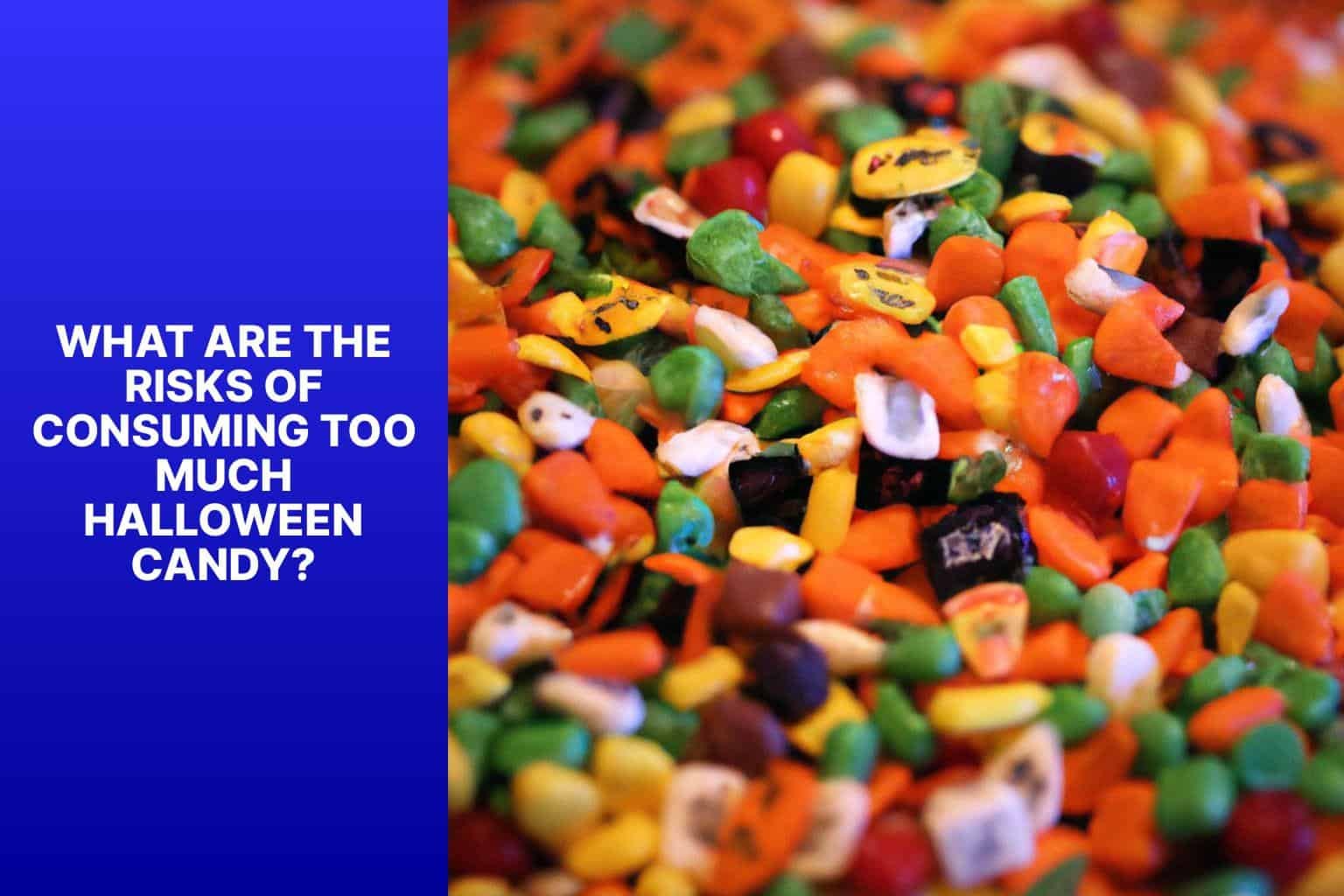
Photo Credits: Rickyshalloween.Com by Joe Roberts
Indulging in Halloween candy may seem harmless, but are there risks involved? Let’s uncover the potential dangers of consuming too much of that sweet loot. From the increased risk of tooth decay to the potential for weight gain and blood sugar spikes, we’ll delve into the dark side of Halloween treats. Prepare to be shocked by the facts lurking behind those seemingly innocent goodies. Brace yourself for a chilling exploration of the risks that come with indulging in excessive Halloween candy.
Increased Risk of Tooth Decay
Consuming an excessive amount of Halloween candy significantly increases the risk of tooth decay. The sugar present in candy feeds mouth bacteria, which in turn produce acids that gradually erode tooth enamel, leading to the formation of cavities and decay.
Tooth decay occurs when bacteria acids attack and break down the enamel of the teeth. The higher the frequency and duration of sugar exposure, the greater the likelihood of decay. Hence, indulging in too much sugary Halloween candy greatly raises the chances of developing cavities.
To reduce the risk of tooth decay, it is crucial to follow proper oral hygiene practices. Brushing your teeth with fluoride toothpaste at least twice a day, daily flossing, and regular visits to the dentist for check-ups and cleanings are essential. Limiting the consumption of candy, particularly sticky or sugary varieties, aids in protecting teeth from decay.
Being mindful of the amount of Halloween candy consumed, especially in the case of children who are more vulnerable to tooth decay, is important. Parents should keep track of their children’s candy intake and establish limits to prevent excessive sugar consumption, thereby effectively reducing the risk of tooth decay and ensuring good oral health.
Weight Gain and Obesity
Weight gain and obesity can occur due to excessive Halloween candy consumption. When indulging in large amounts of candy, it is important to be conscious of its impact on weight and overall health.
Consuming an excess number of calories from candy can lead to weight gain. Candy typically contains high levels of sugar and calories, which can create an energy imbalance if not counteracted with regular exercise. Consuming more calories than your body requires can result in gradual weight gain.
Consistently consuming significant quantities of candy can also contribute to obesity, a condition characterized by excessive body fat. The elevated sugar content in candy can contribute to weight gain and heighten the risk of obesity-related health problems such as heart disease and type 2 diabetes.
To prevent weight gain and obesity, it is crucial to moderate your Halloween candy consumption. Here are some suggestions:
– Limit the amount of candy you consume each day.
– Practice portion control by enjoying smaller servings of candy instead of consuming large quantities at once.
– Complement candy consumption with healthy choices like fruits, vegetables, and lean proteins.
– Engage in regular physical activity to burn calories and maintain a healthy weight.
By being mindful of your candy consumption and making healthier choices, you can reduce the risk of weight gain and obesity often associated with Halloween candy. Prioritize your overall well-being and make informed decisions regarding your diet and lifestyle.
Blood Sugar Spikes
Blood sugar spikes, also known as hyperglycemia, can occur when consuming large amounts of sugary Halloween candy. Eating excessive candy can rapidly increase blood sugar levels, leading to insulin resistance and negative effects on overall health.
Individuals with diabetes or pre-diabetes should be particularly mindful of these blood sugar spikes. Consuming excessive amounts of sugary candy can increase the risk of developing diabetes. Therefore, it is crucial to monitor blood sugar levels and maintain stable glucose levels to avoid complications.
To prevent blood sugar spikes, it is recommended to limit Halloween candy consumption. One can opt for candy options with lower sugar content or choose healthier treats to better manage blood sugar levels. Balancing candy intake with physical activity and making healthy food choices can also contribute to regulating blood sugar levels.
Tips for Moderating Halloween Candy Consumption
Indulging in Halloween candy is one of the highlights of the season, but it can be easy to go overboard. In this section, we’ll dive into some helpful tips to moderate your Halloween candy consumption. From setting limits to practicing portion control, we’ll explore practical strategies to enjoy your treats without overindulging. And to add a healthy twist, we’ll discuss how you can offset your candy intake with smart choices. Get ready to satisfy your sweet tooth while keeping it balanced!
Set Candy Consumption Limits
Setting candy consumption limits is crucial for managing Halloween candy intake. Here are some strategies to help incorporate the keywords “set candy consumption limits“:
1. Establish a daily candy allowance: Set a limit on the number of candies you or your child can have each day. For example, you could set a maximum of 2-3 small candies or 1 fun-sized candy bar.
2. Use a candy jar or container: Set a specific amount of candies for the week in a jar or container. Once the candies are finished, there will be no more until the next designated time.
3. Control candy distribution: When giving out candies, make sure to set limits on the number you give to each trick-or-treater. This will prevent excessive leftovers.
4. Trade or donate excess candy: Encourage children to exchange their extra candies with friends or siblings for non-candy items like stickers or small toys. Alternatively, consider donating the excess candies to local charities or food banks.
5. Set a time limit: Determine a specific time period for consuming Halloween candies, such as one week or until the end of the month. Once the allocated time is up, either discard or donate any remaining candies.
By incorporating these strategies to set candy consumption limits, you can enjoy Halloween treats in moderation and avoid overindulgence.
Practice Portion Control
– Practice portion control by dividing Halloween candy into smaller portions to track consumption.
– Instead of eating directly from the bag or container, use a plate or bowl for a predetermined portion to avoid overeating.
– Create the illusion of a larger serving by using smaller plates or bowls. This can help satisfy cravings without consuming excessive amounts.
– Be mindful of recommended daily sugar intake. The American Heart Association suggests limiting added sugars to 25 grams per day for women and 36 grams per day for men.
– Instead of indulging in just one type of candy, have a small portion of each if you enjoy multiple types. This way, you can control overall consumption while still enjoying different flavors.
– Take your time when eating candy. Slowly savor each bite to feel more satisfied and reduce the temptation for larger portions.
– Listen to your body’s hunger and fullness cues. Stop eating when comfortably full, even if there is still candy left.
– Remember, it’s okay to indulge in Halloween candy, but practice self-control and limit portion sizes to maintain a balanced diet.
Offset Candy Intake with Healthy Choices
When indulging in Halloween candy, offset the intake with healthy choices to maintain a balanced diet. Consider the following options:
- Increase fruit and vegetable consumption: Incorporate more fruits and vegetables into meals and snacks to boost intake of essential vitamins, minerals, and fiber.
- Choose healthier snacks: Opt for nutritious snacks like nuts, seeds, or yogurt instead of more candy. These options provide protein and healthy fats to keep you satisfied.
- Stay hydrated: Drink water throughout the day to stay hydrated and help curb cravings for sugary treats.
- Engage in physical activity: Get active to burn off extra calories and maintain a healthy weight. Enjoy activities such as walking, dancing, or playing sports.
- Moderate portion sizes: Limit candy consumption by practicing portion control. Enjoy small amounts of favorite treats without overindulging.
By offsetting candy intake with healthy choices like these, you can maintain a balanced diet and minimize the negative impacts of excessive sugar consumption. Remember to listen to your body and make choices that align with your individual health goals.
How to Handle Leftover Halloween Candy
Leftover Halloween candy? No problem! Discover clever ways to give it a new life and avoid sugar overload. From donating to a local charity or food bank, freezing for later delights, to repurposing in irresistible baking or desserts, we’ve got you covered. So bid farewell to post-Halloween guilt and let’s turn those sweet treats into something amazing! Let’s dive in and get creative with our candy stash!
Donate to a Local Charity or Food Bank
Donate excess Halloween candy to a local charity or food bank to share joy and make a positive impact in your community. By donating to a local charity or food bank, you can ensure that those in need have the opportunity to enjoy sweet treats. Here are some suggestions on how to donate to a local charity or food bank:
1. Find a local charity or food bank: Research and find local organizations that accept candy donations during Halloween. Contact these local charities or food banks to learn about their guidelines and drop-off locations for your donation to a local charity or food bank.
2. Package the candy: Sort the candy into individual packages or bags for easy distribution to a local charity or food bank. Check each package or bag for any opened or damaged items and discard them appropriately.
3. Follow guidelines: It is important to follow the specific criteria or guidelines set by the local charity or food bank when donating candy. This may include restrictions on the type of candy or dietary considerations. By following their guidelines, you can ensure that your donation can be utilized effectively by the local charity or food bank.
4. Deliver the donation: Take the packaged candy to the designated drop-off location specified by the local charity or food bank. If available, you can also schedule a pick-up for your donation. It is important to consider the hours of operation and any COVID-19 protocols implemented by the organization when delivering your donation to the local charity or food bank.
5. Consider additional donations: You can also inquire about other items that the local charity or food bank may need, such as non-perishable food, toiletries, or clothing. By considering additional donations, you can contribute further to their cause and make a greater impact within your community.
Remember, donating to a local charity or food bank not only helps those in need, but also promotes kindness and goodwill during Halloween. By donating to a local charity or food bank, you can spread the Halloween spirit and make a positive difference in your community.
Freeze for Later Use
Freezing Halloween candy is a great way to extend its enjoyment and prevent waste. Here are the steps to freeze Halloween candy:
Sort the candy: Separate the types of candy into groups to make freezing and accessing later easier.
Remove packaging: Take the candy out of individual wrappers or packaging to prevent moisture from affecting its quality.
Place in freezer bags: Transfer the candy into freezer-safe bags or containers. Label each bag with the candy type and freezing date for freshness tracking.
Seal tightly: Remove excess air from the bags before sealing to prevent freezer burn and maintain flavor.
Store in the freezer: Arrange the bags of candy for easy access and visibility in the freezer.
Thaw before enjoying: Take the frozen Halloween candy out of the freezer and let it thaw at room temperature for a few minutes before eating.
True story: Last Halloween, I had an abundance of leftover candy that my kids couldn’t finish. Instead of wasting it, I froze it for later use. Throughout the year, I would occasionally surprise my kids with a bag of frozen candy. They were always excited and grateful to have Halloween candy long after the holiday. Freezing the candy not only prevented waste, but also provided delightful surprises for my children at different times of the year.
Repurpose in Baking or Desserts
To repurpose leftover Halloween candy in baking or desserts, try these creative ideas:
1. Make Candy Bar Blondies: Chop up Snickers, Milky Way, or Kit Kat bars and add them to a classic blondie recipe for a gooey and delicious treat. For more information on how much Halloween candy to buy, check out this article on Martha Stewart’s website.
2. Create Candy-Stuffed Cookies: Incorporate bite-sized candy pieces like M&M’s, Reese’s Pieces, or crushed candy corn into your favorite cookie dough recipe for a surprise burst of flavor.
3. Make Candy Bark: Melt leftover chocolate and spread it onto a baking sheet. Top it with chopped candy, pretzels, nuts, or sprinkles, then let it harden. Break it into pieces for a sweet and crunchy snack.
4. Prepare a Candy Milkshake: Blend your favorite candy with vanilla ice cream and milk for a decadent and indulgent milkshake. Add toppings like whipped cream and crushed candy for extra flair.
These dessert ideas are a great way to repurpose leftover Halloween candy in baking or desserts and satisfy your sweet tooth. Get creative and experiment with different candy combinations in your baking. Remember to enjoy these treats in moderation and consider sharing them with friends and family to spread the joy of Halloween.
Frequently Asked Questions
How much Halloween candy should you buy?
According to the online calculator developed by Shipt and Mars Wrigley, you can determine the amount of Halloween candy to buy by considering factors like time, number of kids, and generosity. The calculator uses mathematical equations to calculate the total candy required.
What are the two sections in the candy calculator?
The candy calculator has two sections. The first section calculates the total candy needed by multiplying time, number of kids, and generosity. The second section calculates the extra candy needed leading up to Halloween by multiplying the number of days before Halloween, household size, and sneakiness level.
How is the total candy required calculated?
The total candy required is calculated by adding the products from the first and second sections of the candy calculator. If rain is forecasted, it is advised to divide the total by 1.5.
What factors should be considered when making plans for Halloween candy?
When making plans for Halloween candy, it is important to consider the cost of buying candy, the type of candy to give out, and the total candy required. It is also advised to consider alternatives like fruit candies for children with allergies and to buy candy that you dislike to prevent family members from eating it before Halloween.
What are some safer alternatives to traditional trick-or-treating?
In light of the COVID-19 pandemic, health experts recommend considering safer alternatives to traditional in-person trick-or-treating. Some suggested alternatives include organizing a family Halloween scavenger hunt, having a Halloween movie night, or participating in fall activities like apple picking.
How does excessive sugar consumption affect health?
Excessive sugar consumption over time can have negative effects on health. While it is okay to indulge in candy in moderation, consuming large amounts of sugar can have detrimental effects on dental health, contribute to weight gain, and lead to other health issues when not balanced with a nutritious diet.
What should you do with excess Halloween candy?
If you have excess Halloween candy, you can consider donating it to organizations. This helps reduce waste and allows others to enjoy the sugary goodness.
